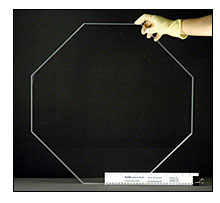
Barr Filters Used in Pan-STARRS
WESTFORD, Mass., March 15, 2006 -- Barr Associates Inc., a maker of precision thin-film coatings and optical filters, was selected to provide large-area filters for the Pan-STARRS (Panoramic Survey Telescope and Rapid Response System) prototype telescope by the Institute of Astronomy at University of Hawaii.
The filters will be 21 inches in diameter and will be used in four identical 1.8 meter telescopes that make up Pan-STARRS.
Jeff Morgan, senior telescope engineer for Pan-STARRS, said, "The physical size of approximately 500 mm for the Pan-STARRS filters is unprecedented in astronomy."
 Pan-STARRS is an innovative design for a wide-field imaging facility being developed at the institute. By using four comparatively small telescopes, each with a 3-degree diameter field of view, the university will develop an economical observing system to observe the entire available sky several times each month.
Pan-STARRS is an innovative design for a wide-field imaging facility being developed at the institute. By using four comparatively small telescopes, each with a 3-degree diameter field of view, the university will develop an economical observing system to observe the entire available sky several times each month.
The immediate goal of Pan-STARRS is to discover and characterize objects approaching the Earth, both asteroids and comets, that might pose a danger to our planet. The huge volume of images produced by this system will also provide data for many other kinds of scientific programs, the university said, and will contribute to astronomical research areas such as solar system astronomy and cosmology.
Pan-STARRS will be able to locate nearly all 1- and 300-km objects that pass by Earth. It will also be capable of cataloging 99 percent of the stars that have been observed by visible light within the northern hemisphere. Stars in the Milky Way galaxy and from neighboring galaxies will be documented; these could include erupting stars, eclipsing binaries, RR Lyrae stars and Cepheids.
The progress of the construction of the filters will be posted on the Pan-STARRS Web site: www.pan-starrs.org
/Buyers_Guide/Materion_Balzers_Optics/c1511